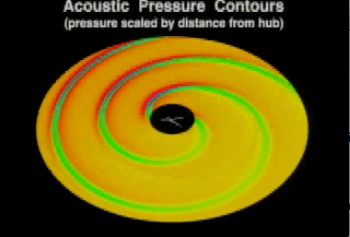HELICOPTER ACOUSTICS CALCULATIONS
ON PARALELL COMPUTERS
Roger Strawn
US Army Aeroflightdynamics Directorate
Lenny Oliker
RIACS
Rupak Biswas
MRJ
NASA Ames Research Center
Moffett Field, CA 94035-1000
Research Objective:
Rotorcraft designers need high-accuracy methods for predicting far-field noise. They also need new techniques for analyzing the computed results. This project seeks to develop new parallel computer algorithms for rotor noise prediction, plus audio and visual rendering of the computed results.
Approach:
This project integrates several new methods to predict and analyze rotorcraft noise. These methods are: 1) a combined computational fluid dynamics and Kirchhoff scheme for far-field noise predictions, 2) parallel computer implementation of the Kirchhoff integrations, 3) audio and visual rendering of the computed acoustic predictions over large far-field regions of space, and 4) acoustic trace backs to the Kirchhoff surface to pinpoint the sources of rotor noise.
Accomplishment Description:
The overall approach has been demonstrated for three test cases. The first case consists of in-plane high-speed impulsive noise and the other two cases show idealized parallel and oblique blade-vortex interaction noise. The computed results show excellent agreement with available experimental data but convey much more information than the experiments about the far-field propagation of rotor noise. The Kirchhoff integrations require little communication between processors and exhibit almost ideal parallel speedup on the IBM SP-2. With 60 SP-2 processors and 86,400 points on the Kirchhoff surface, we can compute a periodic time-history of 180 pressure evaluations for each of 7533 far-field observer locations in about 5 CPU hours.
Significance:
When taken together, these new analysis methods exploit the power of new computer technologies and offer the potential to significantly improve our prediction and understanding of rotorcraft noise. The new audio and visual rendering techniques present a much more complete picture of rotor noise propagation than can be obtained from a handful of experimental microphones.
Future Plans:
These new analysis tools will be applied to rotor blades with self-generated blade-vortex interactions (BVIs). Audio and visual rendering of the far-field noise for these cases will provide extensive 3-D information on BVI noise propagation from helicopters and tiltrotors.
Related Publications:
Strawn, R. C., Oliker, L., and Biswas, R., "New Computational Methods for the Prediction and Analysis of Helicopter Noise," AIAA 96-1696, presented at the 2nd AIAA/CEAS Aeroacoustics Conference, State College, PA, May 6-8, 1996. (submitted for publication to the AIAA Journal of Aircraft )
Point of Contact:
Roger Strawn
NASA Ames Research Center
Moffett Field CA 94035-1000
